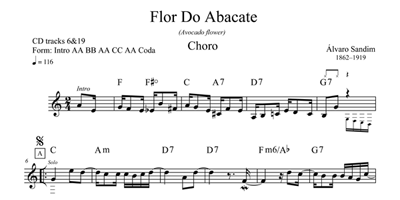Choro Music was born with the initial aim of sharing Brazilian instrumental music with the world through play-along songbooks, so that people could hear the songs as well as play them with their own instruments.
The inspiration behind Choro Music first struck when I moved to the United States in 1995 and discovered the world of “play alongs.” As a flutist in love with instrumental music, I was amazed by the possibility that I could play Bach, Vivaldi, Handel and many others, accompanied by a first-class orchestra.
There wasn’t just a repertoire of classical music but also a vast jazz selection available in play-along format. Following my excitement at the chance to play along with an orchestra everything I had learned and practiced in my life as a musician, there soon came the question: what about Brazilian instrumental music, what would be available?
The answer to that question was actually linked to another question: what’s the most popular Brazilian musical genre in the world?
If you answered bossa nova, you are correct, and that was basically all that was available in the market in terms of play-alongs. Publishers Hal Leonard and James Aebersold accomplished a great deal in their production of jazz play-alongs, and Hal Leonard in particular built an excellent collection dedicated to bossa nova.
But there was a huge dearth in terms of choro music or Brazilian instrumental music in general, which was immensely frustrating for me as a fan of those genres. Over time, it became my dream to produce play-alongs for choro, and in 2006 I began to make that dream a reality by founding Choro Music.
Filling a gap in Brazilian instrumental music
I was born and raised in a musical family, and was influenced by my older sisters’ tastes for classical music as well as my father’s and older brother’s tastes for Brazilian music, namely samba and choro. In fact, my brother, Nelson Dalla Rosa, composed a samba-enredo paying homage to singer-songwriter Chico Buarque which was chosen to be performed at the 1998 Carnival of Brazil by the Mangueira samba-school, winning them the champion title that year. You can watch here: http://www.youtube.com/watch?v=cwabwqijMGQ
At 14 years of age, accompanied by my brother on guitar and cavaco, I began practicing choro with a recorder (buying a transverse flute at that time for me was simply out of the question because of the cost).
My first lessons in musical theory would come from my brother and brother-in-law. I felt it was necessary to learn how to read sheet music, and once I did, a whole universe opened itself to me. At 15 years of age, I worked as an office boy and used the majority of my pay to buy sheet music—for Bach, Vivaldi, and other baroque music, and especially for choro. I had an insatiable thirst for more choro, and was always hearing the same thing from the clerks at the stores I frequented (Casa Manon, Casa Bevilácqua, Casa Amadeus): “You again? You were just here 3 months ago and bought everything we had!”
At 19, working as a computer programmer, I was finally able to afford not only a transverse flute but also music lessons with the best flute teacher in the city at the time: Professor João Dias Carrasqueira, who became a great mentor for me. At 20 years old, I entered the world of choro professionally when I began frequenting the choro music club in Sao Paulo, where I had the opportunity to play with Carlos Poyares.
When I look back on those days, I immediately think of how subpar the tools we had available to us were for learning and developing a choro repertoire. Today, we at Choro Music strive to produce play-alongs that offer extremely efficient mechanisms for learning choro, and we hope our efforts will help to fill a significant gap in the world of Brazilian instrumental music.
Play-alongs as recreation, education, and even work
The play-along universe provides music lovers and professionals alike with an incredible spectrum of possibilities. As a learning tool, you can hear an expert interpretation of a song and then develop your own technique, memorize a piece, build up your own repertoire, develop your improvisational skills, and you can utilize the digital tools that are available in this day and age: among the countless possibilities that present themselves to us musicians, I can list two that are immediately applicable:
- ability to easily alter the tempo of a piece (while maintaining the key) and gradually increase the speed until you’re able to play.
- ability to alter the key (while maintaining the speed).
An explanation of how this is done can be found on the “resources” section of our site.
Playing Brazilian instrumental music with good accompaniment, especially if you have quality sound system, is refreshing to the soul. As an example, I invite you to play (or just listen to) the following segment of the composition Caminhos, from our Marquinho Mendonça songbook:
(click on the thumbnail to enlarge)
-
play along
Playback -
listen to this segment with Marquinho Mendonça's solo
full track
Or this exciting choro, brought to light by Jacob do Bandolim:
(click on the thumbnail to enlarge)
-
play along
Playback -
listen to this segment with Nailor Proveta's solo
full track
As part of my work, I currently utilize the Choro Music play-alongs when I lecture, or when I perform music in public.
The work of producing play-alongs for Brazilian instrumental music is practically interminable and we hope to continue and bring our songbooks to the entire world.
 Daniel Dalarossa
Daniel Dalarossa
Founder and President



 Shopping cart
Shopping cart


